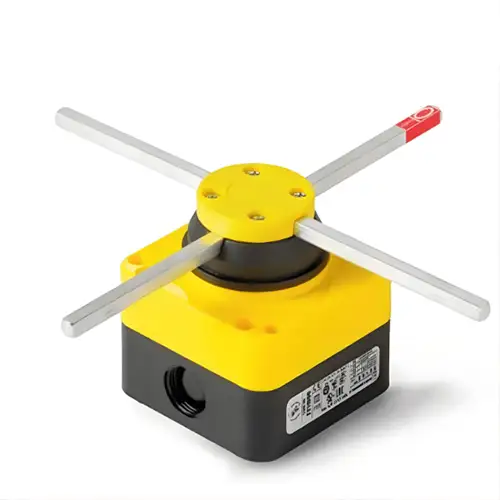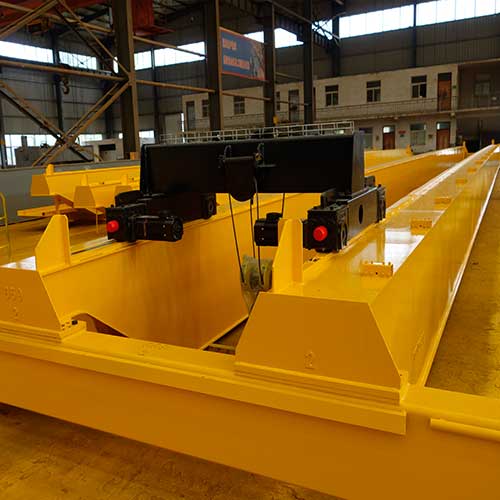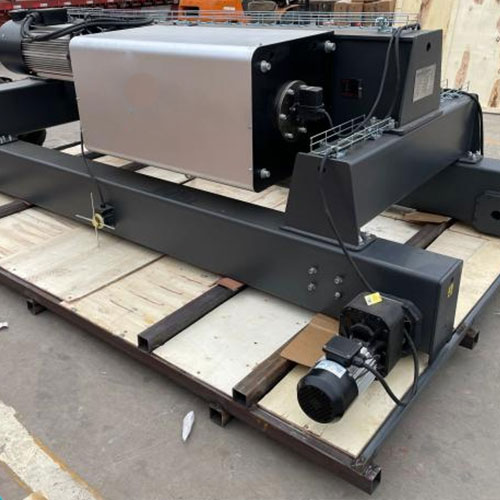Overhead Crane Cross Limit Switch: Types and Safety Guide
Learn how cross limit switches improve overhead crane safety, explore available types, and understand what matters when selecting the right model.
Category: Crane Kit Parts
Your Trusted Overhead Crane Manufacturer & Supplier
Overhead Crane Cross Limit Switch
A Buyer’s Guide to Safety, Types, and Selection of Cross Limit Switch of Overhead Travelling Crane
Overhead Crane Cross Limit Switch: A Buyer’s Guide to Safety, Types, and Selection
Overhead Crane Cross Limit Switch
Cross limit switches may not be the first thing crane buyers think about—but they should be.
In overhead cranes, a cross limit switch is a mechanical device installed to limit the movement of the crane's traveling mechanism, especially along the end approach of the runway. Its main job is to trigger a stop or deceleration signal when the crane reaches a preset boundary. You’ll often see it mounted near the end of the runway beam or along the track, acting like a traffic cop that keeps things from going too far.
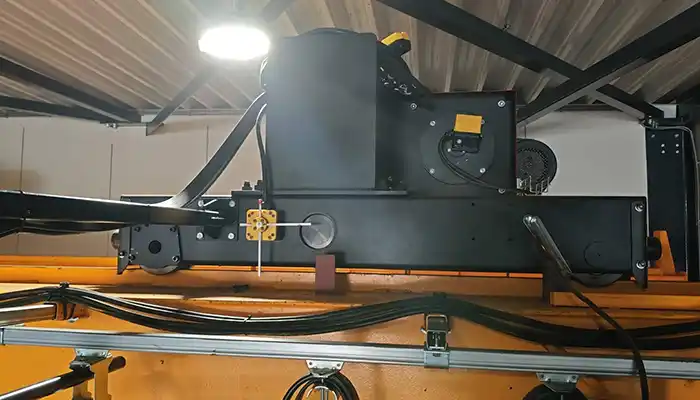
What Does It Actually Do?
- When the crane travels too far in either direction, the limit switch gets triggered by a cross-style lever hitting a stopper or cam.
- Depending on the type, the switch either cuts off power completely or sends a signal to slow down before stopping.
- In short: it stops your crane from crashing into end stops, equipment, or even the building wall.
This isn't just about convenience—it's about protecting your crane, your load, and the people working nearby. Picture on the left: Crane Cross Limit Switch Assembly on The European style Electric Hoist
Why Is It Considered a Crane Safety Device?
If you’ve ever seen a crane overshoot and slam into the runway buffer, you already know the damage can be costly. Worse, it can be dangerous.
Limit switches help avoid:
- Mechanical damage to end stops, motors, or wheel blocks
- Structural damage to buildings, rails, or runway beams
- Unexpected shutdowns or repair downtime
- Accidents involving workers near the crane path
Without a cross limit switch, even a well-maintained crane can overrun due to momentum or control delay. That’s especially true in cranes carrying heavy loads or operating at higher speeds.
How It Fits into a Safe Crane System
In many cases, a cross limit switch works alongside:
- Main travel limiters for long travel (crane bridge motion)
- Hoisting limit switches to stop over-raising the hook
- Electrical interlocks in control panels
Put simply: the cross limit switch is part of your crane’s built-in protection plan.
In today’s environment, where safety rules are tighter and inspections are more common, buyers should treat cross limit switches as standard equipment, not optional extras.
Working Principle of Cross Limit Switches
At first glance, a cross limit switch looks simple—a metal box with a cross-shaped lever sticking out. But don’t let the appearance fool you. Inside that box is a set of mechanical contacts that play a direct role in how safely your overhead crane moves. The cross lever and the internal switching mechanism work together to detect position and trigger a response.
How the Cross Lever and Internal Mechanism Work
The “cross” in the name comes from the shape of the external lever, usually forming a “+” or “X” shape. This lever is mounted on a rotating shaft connected to cams and contacts inside the switch housing.
- As the crane moves along its track, a fixed striker plate or cam mounted on the crane runway or frame comes into contact with one of the cross arms.
- This rotates the shaft, which in turn activates internal micro-switches or mechanical contacts.
- The amount of rotation determines whether the switch simply sends a signal or fully cuts the circuit.
Depending on the model, some switches are spring-loaded to return to the neutral position after activation, while others hold position until reset manually or by reversing direction.
What Happens When It’s Triggered?
That moment of contact is when the cross limit switch goes to work. What it does next depends on the type:
- Single-speed switches: Immediately cut off power to the traveling motor once the preset angle (typically 180°) is reached.
- Double-speed switches: At the first cam position (around 180°), they send a deceleration signal to slow down the crane. At the second cam position (near 360°), they cut power completely, bringing the crane to a stop.
In both cases, it’s a fully mechanical action. That means even if there’s a glitch in the PLC or control panel, the limit switch will still do its job. It works as a kind of physical fail-safe, which is why inspectors and safety engineers like it so much.
Preset Positions and Automated Crane Stopping
Crane travel limits aren’t arbitrary. During installation, technicians align the limit switch’s lever with physical stoppers or cams placed on the track. These define the “no-go” zones at the ends of travel.
- Once the crane reaches this point, the system responds automatically—no need for the operator to guess or react manually.
- In setups using double-speed switches, the crane slows down before reaching the end to reduce wear and improve load handling stability.
- In single-speed systems, the crane just stops as soon as it touches the lever—suitable for simpler or lower-speed operations.
This kind of automation is especially helpful in busy workshops or factories, where the crane operator is managing both motion and load control. It makes the system more predictable and less prone to human error.
In short: The cross limit switch acts as an automatic brake signal triggered by position. Once installed and aligned, it does its job in the background, helping your crane stop safely—every single time.
Types of Cross Limit Switches
Cross limit switches come in two main types: single-speed and double-speed. Each type serves a different purpose depending on your crane’s load capacity, working environment, and control needs. Let’s walk through the difference—because choosing the wrong one could mean poor stopping control or even safety issues later.
Single-Speed Type (180° Rotation)
This is the most common type used in basic overhead crane systems, especially in smaller workshops or warehouses. It's called a 180-degree type because the internal shaft rotates halfway (half a full turn) before engaging the shutoff mechanism.
How It Works
- When the crane reaches the preset travel boundary, the cross lever gets pushed, rotating the shaft 180°.
- At that point, a mechanical contact inside is triggered to cut off power to the travel motor instantly.
- The crane stops right there—no warning, no deceleration phase. It's a hard stop, but effective.
Best For
- Cranes with a load capacity under 10 tons
- Systems where precise slowing isn't required
- Budget-conscious projects that still require basic safety
Advantages
- Simple and straightforward mechanism
- Fewer moving parts, which means less maintenance
- Often more affordable than double-speed types
- Easy to replace and adjust if needed
Limitations
- Sudden stops may cause wear on mechanical parts over time
- Not ideal for high-speed or high-inertia operations
- Less suitable when transporting fragile loads that can shift during a quick stop
Think of it like a reliable handbrake—nothing fancy, but it gets the job done for everyday use.
Double-Speed Type (360° Rotation)
This version is more advanced and more common on medium to large-capacity overhead cranes, especially where speed, load stability, and smooth handling matter.
It's called a 360-degree type because the internal shaft rotates fully around to activate two stages of contact—first to slow down, then to stop.
How It Works
- As the crane nears the limit, the first contact (usually at 180°) sends a deceleration signal, causing the crane to reduce speed.
- If the crane keeps moving and the lever rotates further (up to 360°), the second contact fully cuts power, bringing it to a stop.
This two-step approach reduces strain on motors and gearboxes and gives the operator smoother control over crane stopping.
Best For
- Cranes over 10 tons or operating at higher speeds
- Workshops handling delicate materials, long loads, or frequent directional changes
- Situations where automated control and safety regulations require more precise stopping behavior
Advantages
- Smoother stopping improves load stability
- Reduces mechanical wear from hard stops
- Complies better with modern safety standards
- Often required for cranes in automated or semi-automated systems
Example Model: DX Z 006
- A commonly used double-speed limit switch with adjustable travel angles
- Compatible with many overhead cranes and gantry cranes
- Modular design and IP65-rated enclosure for outdoor or dusty use
Limitations
- Higher cost upfront
- Slightly more complex to install and adjust
- Not necessary for low-speed, light-duty cranes
In short, if your crane handles heavy loads or operates in demanding conditions, the double-speed switch is the safer and smarter option—like cruise control with a built-in brake.
Key Selection Factors for Crane Buyers
Buying a cross limit switch isn't just about picking the cheapest model online. You need to match the right type with your crane's size, function, and working environment. If you're not careful, you could end up with a switch that doesn't stop when it should—or worse, damages your crane or violates safety regulations.
Crane Type and Load Capacity
The first and most obvious factor is the size and duty level of your crane. The type of limit switch you choose needs to suit how the crane moves, how fast it travels, and what kind of loads it handles.
What to Think About:
For cranes under 10 tons
- A single-speed (180°) limit switch is usually enough.
- These cranes often move slower and carry lighter loads, so a simple stop is sufficient.
For cranes over 10 tons or high-speed systems
- A double-speed (360°) model is strongly recommended.
- Slowing down before stopping helps reduce brake wear and prevents swinging or load shift.
Practical Tip:
Don’t rely on a “one size fits all” limit switch just because it’s cheap. Oversized cranes running with undersized safety devices is a recipe for early failure—or inspection trouble later.
Adjustment and Compatibility
Every crane setup is slightly different. That’s why adjustability is a big deal. A switch that can’t align properly with your crane’s travel path will either trigger too early, too late, or not at all.
What to Look For:
- Models with both horizontal and vertical adjustment This allows the lever arm to be fine-tuned during installation.
- Sliding crossbarsThese help align the lever with the actual movement range of the crane trolley or bridge.
- Liftable vertical rods Useful when your end stops or striker points vary in height.
- Compatibility with various rail types Make sure the switch mount can be adjusted for cranes running on straight tracks, curved beams, or non-standard runway structures.
Misaligned switches are a common cause of false trips or failure to stop. Adjustable models reduce installation time and help future-proof your crane if the layout changes later.
Compliance and Certification
You can’t ignore this part—especially if you're operating in a regulated industry or expect a site inspection.
Since 2022, many national crane safety codes have been updated. They now require more advanced and redundant limit protection, especially on gantry and overhead cranes.
Key Requirements to Know:
- Dual-limit protection is now mandatory in most regions
. One mechanical limit (like a cross limit switch). One electrical or programmable backup - Certified models only Make sure your supplier provides documentation showing the switch meets crane safety standards such as GB/T 14406, ISO, or relevant local safety codes.
- Modular and testable design Post-2025, many cranes will require modular switch designs that allow field testing and easy maintenance. It’s best to buy ahead.
Check the IP rating of the enclosure. For outdoor or dusty environments, IP65 or higher is a must to protect internal contacts from dirt and moisture.
Practical Procurement Tips
Once you know which type of cross limit switch your crane needs, the next step is buying smart. And honestly, the difference between a smooth installation and weeks of headaches often comes down to what you check before clicking that “Order” button.
Below are some field-tested tips to help you avoid common mistakes and buy the right cross limit switch with confidence.
Decode Model Suffix Codes
Many crane limit switches use coded suffixes in their product names, but few buyers know what they actually mean. Learn to read these codes—it’ll save you from buying the wrong switch.
What to Check:
Look for numerical suffixes like “006” or “Z006”
- These typically refer to double-speed, 360° rotation models
- Double-speed types have two internal contacts for deceleration and full stop
- If you only need single-speed, look for codes like “001” or “180”
Some codes also indicate adjustability or protection level
- For example: “-IP65” = waterproof and dustproof
- “DX” or “ZT” prefixes may indicate modular designs or patent models
Always ask the supplier to explain the exact function of the code, or request a specification sheet. Don’t assume two models with the same outer casing perform the same.
Choose Patent-Certified Manufacturers
A cross limit switch might look like a small part, but if it fails, it could cost you downtime—or worse, an accident.
That’s why you should prioritize certified or patented designs. These manufacturers usually have better internal engineering and reliability testing behind their products.
What to Look For:
- Clear mention of patent registration numbers
- Certification to standards like ISO 9001, CE, or GB/T 14406
- Documentation showing test results or design diagrams
- A physical company presence—not just a logo on an online marketplace
Generic, unverified limit switches might work at first—but they may not trigger properly under load or over time. Certified ones are more likely to last, and easier to replace with the same specs later.
Review Product Parameters and Technical Documents
Before you order, always read through the product specs—and not just the product title. Many key features are buried in datasheets or downloadable manuals.
Key Parameters to Review:
- Rotation angle (180° vs. 360°)
- Number of internal contacts (single vs. dual)
- Lever length and adjustability range
- Material and IP rating of the enclosure
- Operating temperature range
- Mounting hole sizes and alignment options
Ask for the installation guide or technical drawing in advance. If the seller can’t provide one, consider it a red flag.
Validate After-Sales Support and Service
This is something too many buyers overlook. A good cross limit switch supplier doesn’t just ship the product—they help when something goes wrong or doesn’t fit.
Questions to Ask the Seller:
- Is there a return or exchange policy if the switch is incompatible?
- Do you provide remote support during installation?
- Can spare parts (like levers or contact blocks) be ordered separately?
- How quickly can replacement units be shipped?
For large crane installations or new factory setups, try to buy a few spare units in advance. This reduces downtime if one fails or needs swapping during adjustments.
Installation and Inspection Checklist
Once you’ve selected the right cross limit switch, getting it installed correctly is the next big step. Poor installation can cause false trips, missed stops, or even mechanical damage. This part is often overlooked—but it’s where safety either happens or fails.
Required IP Rating: Don’t Go Below IP65
Cranes operate in all kinds of conditions—dusty workshops, outdoor yards, humid plants. Your limit switch must be sealed well enough to survive that environment.
Why IP65 is the Minimum:
- IP6X = Fully protected against dust ingress
- IPX5 = Protected against low-pressure water jets from any direction
- Anything less than IP65 risks corrosion, contact failure, or short circuits
If the crane is outdoors or near heavy mist (like steel plants or ports), consider IP66 or even IP67. It may cost a bit more, but it’ll outlast a basic model by years.
On-Site Testing: Manual Lever Activation
Before the crane is put into operation, the cross limit switch must be tested manually. This is not optional.
How to Test It:
- Manually push the cross lever in both directions
- Listen for a clear click sound from the internal switch
Observe the response signal on the control panel or junction box
- Single-speed type: motor should stop immediately
- Double-speed type: first signal should trigger slow down, second should stop the motion
Test each travel direction (forward and reverse). Ensure the contacts are not sticky and the response is immediate. A delay of even half a second is too much in some cranes.
Tooth Spacing: Critical for Consistency
In switches with mechanical striker teeth or bumpers, the spacing must be precise. Misaligned teeth can cause premature activation—or fail to trigger at all.
Installation Guidelines:
- Standard spacing between stop tooth and deceleration tooth: 10–15 cm
- Use a caliper or measuring gauge to ensure even distance across travel zones
- For adjustable switches, lock all fasteners tightly after final positioning
Ongoing Inspection:
- Inspect every 6 months
- If the spacing error exceeds 2mm, it must be recalibrated immediately
- Worn or bent trigger levers should be replaced, not bent back
Acceptance Criteria Before Commissioning
Before officially handing over the crane for use, the cross limit switch must meet a few clear acceptance points.
Checklist Before Sign-Off:
- ✅ Switch housing is securely mounted (no vibration looseness)
- ✅ IP65 seal is intact, with no visible cracks or cable entry leaks
- ✅ Manual activation produces immediate control circuit response
- ✅ Deceleration and stop signals work in correct order (for dual-speed models)
- ✅ Switch alignment is centered and unobstructed
- ✅ Tooth spacers are correctly positioned and firmly installed
- ✅ Labeling and model code are visible for future maintenance
- ✅ Vendor documentation (specs, certificate, wiring diagram) is stored on file
Quick Tip for Installers:Take a photo of the final installed switch, wiring connections, and spacing. This makes future inspections easier and gives you proof of proper setup in case of warranty claims.
Maintenance and Legal Compliance
Keeping your cross limit switches in top shape isn’t a “set and forget” deal. Regular maintenance is key—not just for smooth operation, but also to stay on the right side of safety laws.
Tooth Spacing Calibration Every 6 Months
The tiny details matter here. The gap between the trigger teeth and the switch lever affects whether the crane stops exactly where it should.
- Check the tooth spacing at least twice a year
- Use precise measuring tools to keep the gap within 2 millimeters tolerance
- If spacing drifts beyond that, recalibrate immediately to avoid false trips or failure to stop
- Bent or worn parts should be replaced, not just bent back—it’s a safety risk otherwise
Routine calibration prevents unexpected downtime and costly accidents.
Legal Requirement: Modular Design After 2025
Starting in 2025, national safety regulations mandate that adjustable cross limit switches must adopt a modular design. This change aims to:
- Improve precision, with a reported threefold increase in limit accuracy
- Make maintenance and part replacement easier and quicker
- Help standardize parts across manufacturers for compatibility
If you’re planning new crane installations or upgrades, prioritize switches that meet this modular design standard. It’s not just a legal tick-box—it saves time and headaches down the road.
Exemptions for Mechanical Transmission Devices
Older mechanical limit switches with gear-driven or cam-based systems may be exempt from the new dual-limit (mechanical + electrical) rule—but only legacy cranes.
- Legacy exemption applies only to existing equipment, not new builds
- For all new cranes, both mechanical and electrical limit devices are mandatory
- Mechanical-only switches may still work but could limit your crane’s compliance and resale value
In short: If your crane is older, check local rules carefully. If you’re buying new equipment, plan to install dual-limit switches from the start.
Final Recommendations for Buyers
Choosing the right cross limit switch can feel tricky—but it doesn’t have to be. Here’s a quick rundown of what to keep in mind.
When to Choose Single-Speed vs. Double-Speed
Single-Speed (180°) switches:
- Ideal for small to medium cranes (under 10 tons)
- Simple and cost-effective—triggers an immediate stop
- Good for less critical environments where slow-down isn’t needed
Double-Speed (360°) switches:
- Best for large or heavy-duty cranes needing smooth stops
- Provides gradual deceleration, reducing mechanical stress
- Required in applications with precise positioning needs or safety standards
Invest in Adjustable and Certified Switches
Adjustable switches with horizontal and vertical alignment features allow for precise fitting on various rail sizes and crane designs.
- This reduces installation headaches and costly misfits
- Certified products (ISO, CE, patents) often come with better quality control
- Certification also means better technical support and longer service life
Spending a little more upfront on certified, adjustable switches saves you from expensive repairs or replacements later.
Ensure Full Compatibility with Crane Control Systems
Your limit switch doesn’t work alone—it’s part of a bigger control circuit.
- Verify the electrical specifications match your crane’s motor controllers and PLC systems
- Confirm the switch signals properly trigger both deceleration and stop commands (for double-speed models)
- If possible, test the switch with your existing control setup before final installation
This step prevents unexpected errors and costly integration delays.
A well-chosen cross limit switch is a small investment with a big impact on safety and reliability. Prioritize quality, adjustability, and compliance to keep your overhead crane running safely for years.
Conclusion
Cross limit switches may seem like small parts of an overhead crane system, but their role is absolutely crucial. They act as the final safeguard that keeps your crane from going beyond safe travel limits, preventing costly damage and, more importantly, protecting your operators and nearby personnel.
Essential for Safety and Smooth Operation
Without properly working cross limit switches, cranes risk over-travel, collisions, or sudden mechanical failures. These switches don’t just stop the crane—they provide controlled deceleration (in double-speed models), which reduces wear on components and extends the crane’s lifespan. In many ways, they are the invisible heroes of crane safety.
Why Proper Selection, Installation, and Maintenance Matter
Selecting the right type—whether single-speed or double-speed—based on your crane’s capacity and precision needs, is the first step. But just choosing isn’t enough. Careful installation, including correct alignment and meeting minimum IP65 protection standards, ensures the switch functions reliably in harsh environments.
Ongoing maintenance, especially checking tooth spacing and switch response regularly, prevents unexpected failures and keeps your crane running smoothly day after day.
Buyers Should Prioritize Key Factors
When shopping for cross limit switches, always look for:
- Safety certifications and compliance with current regulations, especially the post-2022 and upcoming 2025 standards
- Adjustability features that let you fine-tune switch positioning for perfect fit and function
- Supplier reliability, including clear product documentation, warranty, and after-sales support
These factors reduce risks, save costs over time, and give you peace of mind that your crane operates safely and efficiently.
In the end, investing in quality cross limit switches is investing in the longevity and safety of your overhead crane system. Don’t cut corners on these components—they pay off in fewer accidents, less downtime, and smoother crane operation.
Related Products
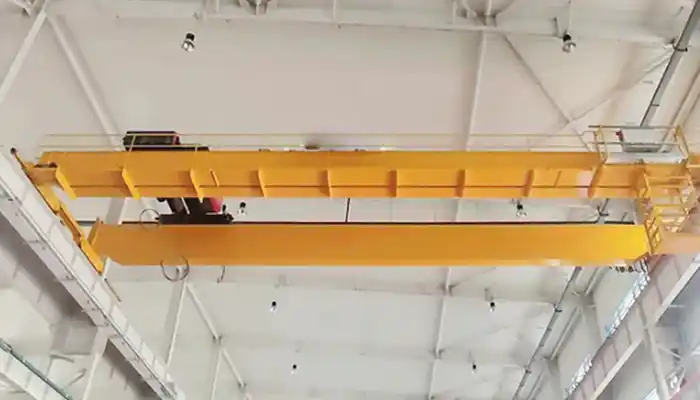
Latest project
Workshop Overhead Crane 5 Ton & 10 Ton Buying Guide
Practical guide for selecting, installing, and maintaining 5 ton to10 ton workshop overhead cranes for safe, efficient, and reliable material handling.
Free consultation to Confirm Parameters & Specifications and Get
Latest Crane Price & Crane Rate.
- Types of overhead cranes : _______?
- Optional: Overhead travelling crane, goliath gantry crane,Slewing jib crane, Single girder or double girder crane,small portable crane or kbk crane, etc.
- Capacity of overhead crane: _______?
- Optional: 0.25ton, 0.5 ton, 1 ton, 2 ton, 3ton, 5 ton, 10 ton,15ton, 20ton, 25 ton, 30ton,35ton, up to 550ton, etc.
- Crane span & lifting height : _______?
- Crane travelling length : _____?
- Control of overhead crane:_______?
- Optional: pendant/ remote/cabin control
- Voltage supply of overhead crane:_____?
- Eg,: 380V50/60HZ,3Phase or others,etc.
- Application/usage of crane:_______?
- Eg,: Steel mill, ,injection mold, cement,stone, concrete,granite, general manufacturing, etc.
Just leave a message via the contact form and our hoist and crane engineer will contact you with in 24working hours.
Get In Touch
